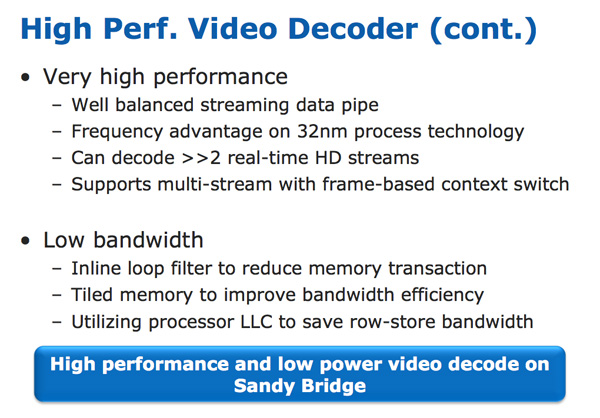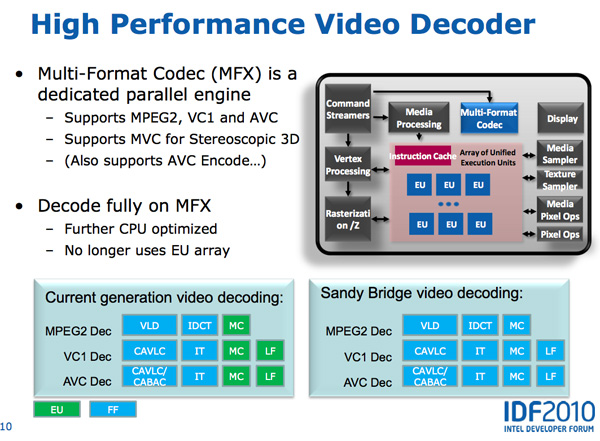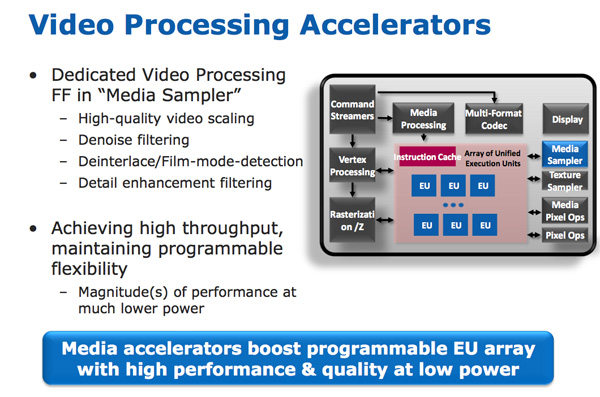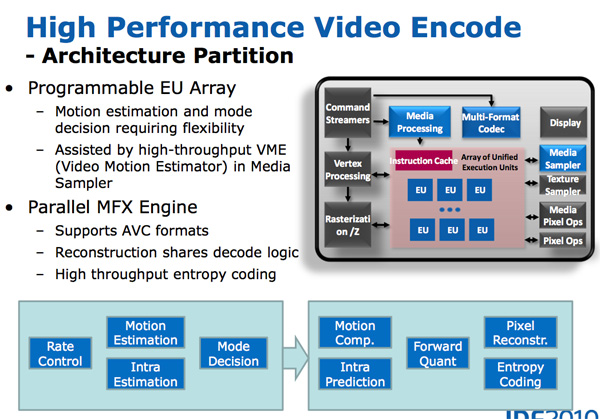The Sandy Bridge Review: Intel Core i7-2600K, i5-2500K and Core i3-2100 Tested
by Anand Lal Shimpi on January 3, 2011 12:01 AM ESTIntel’s Quick Sync Technology
In recent years video transcoding has become one of the most widespread consumers of CPU power. The popularity of YouTube alone has turned nearly everyone with a webcam into a producer, and every PC into a video editing station. The mobile revolution hasn’t slowed things down either. No smartphone can play full bitrate/resolution 1080p content from a Blu-ray disc, so if you want to carry your best quality movies and TV shows with you, you’ll have to transcode to a more compressed format. The same goes for the new wave of tablets.
At a high level, video transcoding involves taking a compressed video stream and further compressing it to better match the storage and decoding abilities of a target device. The reason this is transcoding and not encoding is because the source format is almost always already encoded in some sort of a compressed format. The most common, these days, being H.264/AVC.
Transcoding is a particularly CPU intensive task because of the three dimensional nature of the compression. Each individual frame within a video can be compressed; however, since sequential frames of video typically have many of the same elements, video compression algorithms look at data that’s repeated temporally as well as spatially.
I remember sitting in a hotel room in Times Square while Godfrey Cheng and Matthew Witheiler of ATI explained to me the challenges of decoding HD-DVD and Blu-ray content. ATI was about to unveil hardware acceleration for some of the stages of the H.264 decoding pipeline. Full hardware decode acceleration wouldn’t come for another year at that point.
The advent of fixed function video decode in modern GPUs is important because it helped enable GPU accelerated transcoding. The first step of the video transcode process is to first decode the source video. Since transcoding involves taking a video already in a compressed format and encoding it in a new format, hardware accelerated video decode is key. How fast a decode engine is has a tremendous impact on how fast a hardware accelerated video encode can run. This is true for two reasons.
First, unlike in a playback scenario where you only need to decode faster than the frame rate of the video, when transcoding the video decode engine can run as fast as possible. The faster frames can be decoded, the faster they can be fed to the transcode engine. The second and less obvious point is that some of the hardware you need to accelerate video encoding is already present in a video decode engine (e.g. iDCT/DCT hardware).
With video transcoding as a feature of Sandy Bridge’s GPU, Intel beefed up the video decode engine from what it had in Clarkdale. In the first generation Core series processors, video decode acceleration was split between fixed function decode hardware and the GPU’s EU array. With Sandy Bridge and the second generation Core CPUs, video decoding is done entirely in fixed function hardware. This is not ideal from a flexibility standpoint (e.g. newer video codecs can’t be fully hardware accelerated on existing hardware), but it is the most efficient method to build a video decoder from a power and performance standpoint. Both AMD and NVIDIA have fixed function video decode hardware in their GPUs now; neither rely on the shader cores to accelerate video decode.
The resulting hardware is both performance and power efficient. To test the performance of the decode engine I launched multiple instances of a 15Mbps 1080p high profile H.264 video running at 23.976 fps. I kept launching instances of the video until the system could no longer maintain full frame rate in all of the simultaneous streams. The graph below shows the maximum number of streams I could run in parallel:
| Intel Core i5-2500K | NVIDIA GeForce GTX 460 | AMD Radeon HD 6870 | |
| Number of Parallel 1080p HP Streams | 5 streams | 3 streams | 1 stream |
AMD’s Radeon HD 6000 series GPUs can only manage a single high profile, 1080p H.264 stream, which is perfectly sufficient for video playback. NVIDIA’s GeForce GTX 460 does much better; it could handle three simultaneous streams. Sandy Bridge however takes the cake as a single Core i5-2500K can decode five streams in tandem.

The Sandy Bridge decoder is likely helped by the very large (and high bandwidth) L3 cache connected to it. This is the first advantage Intel has in what it calls its Quick Sync technology: a very fast decode engine.
The decode engine is also reused during the actual encode phase. Once frames of the source video are decoded, they are actually fed to the programmable EU array to be split apart and prepared for transcoding. The data in each frame is transformed from the spatial domain (location of each pixel) to the frequency domain (how often pixels of a certain color appear); this is done by the use of a discrete cosine transform. You may remember that inverse discrete cosine transform hardware is necessary to decode video; well, that same hardware is useful in the domain transform needed when transcoding.
Motion search, the most compute intensive part of the transcode process, is done in the EU array. It's the combination of the fast decoder, the EU array, and fixed function hardware that make up Intel's Quick Sync engine.













283 Comments
View All Comments
Rick83 - Monday, January 3, 2011 - link
I just checked the manual to MSI's 7676 Mainboard (high-end H67) and it lists cpu core multiplier in the bios (page 3-7 of the manual, only limitation mentioned is that of CPU support), with nothing grayed out and overclockability a feature. As this is the 1.1 Version, I think someone misunderstood something....Unless MSI has messed up its Manual after all and just reused the P67 Manual.... Still, the focus on over-clocking would be most ridiculous.
Rick83 - Monday, January 3, 2011 - link
also, there is this:http://www.eteknix.com/previews/foxconn-h67a-s-h67...Where the unlocked multiplier is specifically mentioned as a feature of the H67 board.
So I think anandtech got it wrong here....
RagingDragon - Monday, January 3, 2011 - link
Or perhaps CPU overclocking on H67 is not *officially* supported by Intel, but the motherboard makers are supporting it anyway?IanWorthington - Monday, January 3, 2011 - link
Seems to sum it up. If you want both you have to wait until Q2.<face palm>
8steve8 - Monday, January 3, 2011 - link
so if im someone who wants the best igp, but doesn't want to pay for overclockability, i still have to buy the K cpu... weird.beginner99 - Monday, January 3, 2011 - link
yep. This is IMHO extremely stupid. Wanted to build a PC for someone that mainly needs CPU power (video editing). An overclocked 2600k would be ideal with QS but either wait another 3 month or go all compromise...in that case H67 probably but still paying for K part and not being able to use it.Intel does know how to get the most money from you...
Hrel - Monday, January 3, 2011 - link
haha, yeah that is stupid. You'd think on the CPU's you can overclock "K" they use the lower end GPU or not even use one at all. Makes for an awkward HTPC choice.AkumaX - Monday, January 3, 2011 - link
omg omg omg wat do i do w/ my i7-875k... (p.s. how is this comment spam?)AssBall - Monday, January 3, 2011 - link
Maybe because you sound like a 12 year old girl with ADHD.usernamehere - Monday, January 3, 2011 - link
I'm surprised nobody cares there's no native USB 3.0 support coming from Intel until 2012. It's obvious they are abusing their position as the number 1 chip maker, trying to push Light Peak as a replacement to USB. The truth is, Light Peak needs USB for power, it can never live without it (unless you like to carry around a bunch of AC adapters).Intel wants light peak to succeed so badly, they are leaving USB 3.0 (it's competitor) by the wayside. Since Intel sits on the USB board, they have a lot of pull in the industry, and as long as Intel wont support the standard, no manufacturer will ever get behind it 100%. Sounds very anti-competitive to me.
Considering AMD is coming out with USB 3.0 support in Llano later this year, I've already decided to jump ship and boycott Intel. Not because I'm upset with their lack of support for USB 3.0, but because their anti-competitive practices are inexcusable; holding back the market and innovation so their own proprietary format can get a headstart. I'm done with Intel.